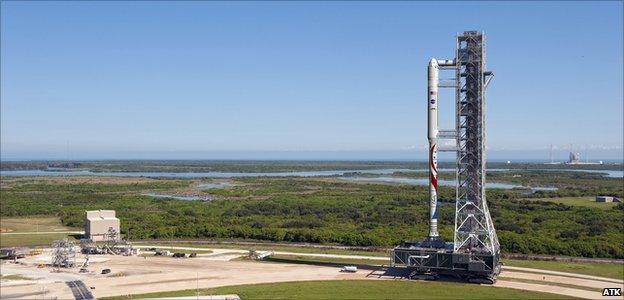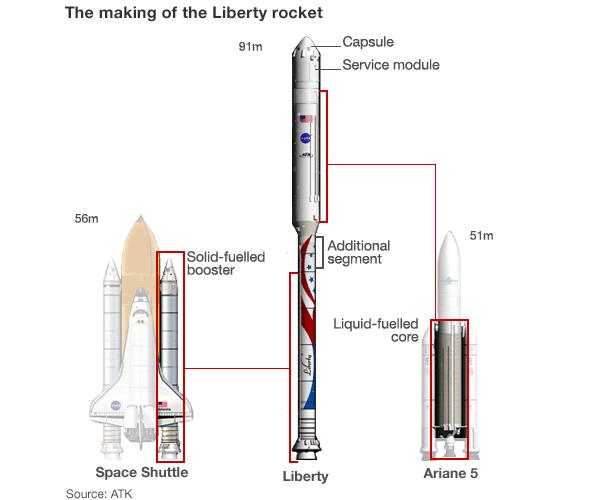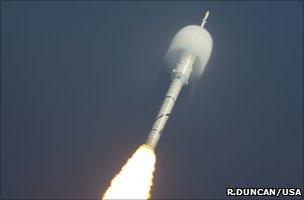New rocket could lift astronauts
- Published

Liberty would launch from the Kennedy Space Center using existing infrastructure
Two of the world's leading rocket companies are joining forces to develop a new vehicle to launch astronauts into orbit.
The bottom part of the proposed Liberty rocket would be based on the solid-fuelled boosters that help get the shuttle off the ground.
The top half would use the liquid-fuelled core-stage technology and engine that powers the Ariane 5.
The concept has been put forward by ATK from the US and Astrium from Europe.
Their idea is being submitted to the US space agency (Nasa), which is seeking commercial solutions to take astronauts to and from the space station following the retirement of the shuttles later this year.
There has been deep concern in the US Congress about the length of time it might take to provide commercial alternatives, leaving America reliant on Russian Soyuz vehicles until perhaps the latter part of this decade.
But ATK and Astrium believe their experience means they could have the 90m-high (300ft) Liberty rocket ready to fly by 2013, and operational with astronauts on board by 2015.

ATK's boosters are already rated to carry humans into space, and the Ariane 5 was originally conceived as an astronaut launcher.
"This team represents the true sense of international partnership in that we looked across borders to find the best for our customers," said Blake Larson, the president of ATK Aerospace Systems Group.

ATK produced the first-stage of a test version of the proposed Ares-1 crew-launch rocket
"Together we combine unique flight-proven systems and commercial experience that allows us to offer the market's most capable launch vehicle along with flexibility to meet a wide variety of emerging needs. Liberty provides greater performance at less cost than any other comparable launch vehicle."
Silvio Sandrone, Astrium's vice-president of launcher sales and business development, told BBC News: "It's a very cool idea; it's got the potential to be a fast development, building on existing experience and existing teams. Certainly it would be cheaper and faster than starting from scratch.
"For Astrium, also, it means accessing a market which has been barred to us up until now."
ATK and Astrium say Liberty's ability to put about 20 tonnes in low-Earth orbit, the altitude occupied by the International Space Station, means it could loft any of the commercial astronaut capsules currently in development. Some of these craft are also chasing financial support from Nasa's Commercial Crew Development (CCDev) Program.
The space shuttle uses ATK's four-segment solid rocket boosters (SRBs) to do the major part of lifting the shuttle stack off the Earth. Liberty would use a first-stage that incorporated a larger, five-segment booster - a technology ATK has already been testing.

Nasa is assisting a number of companies in the development of commercial crew systems
A five-segment booster would have formed the first stage of Nasa's Ares-1 crew launcher before it was abandoned as a concept. Indeed, in shape the Ares and Liberty designs look very similar.
Europe's Ariane 5 was initially conceived as the launcher that would put a mini-shuttle, called Hermes, in orbit. When European Space Agency (Esa) member states decided to cancel this shuttle project on the grounds of cost, the Ariane 5 was turned into a commercial satellite launcher.
Today, this 50m-high rocket puts just over half of all the large telecommunications satellites in orbit each year.
The Ariane's core stage, which is prepared in northern France, uses liquid hydrogen and liquid oxygen as its propellants. With its Vulcain-2 engine, this core stage has now powered Ariane on more than 40 consecutive successful missions over the past eight years. It is considered highly reliable.
"Obviously, there are modifications we will need to make. The Vulcain engine as you know is ignited on the ground, but on Liberty it would need to ignite in the vacuum of space. This is something Europe can do. Ariane's upper-stage has a cryogenic engine that can ignite in a vacuum," Mr Sandrone told BBC News.
- Published8 December 2010
- Published11 October 2010
- Published31 August 2010